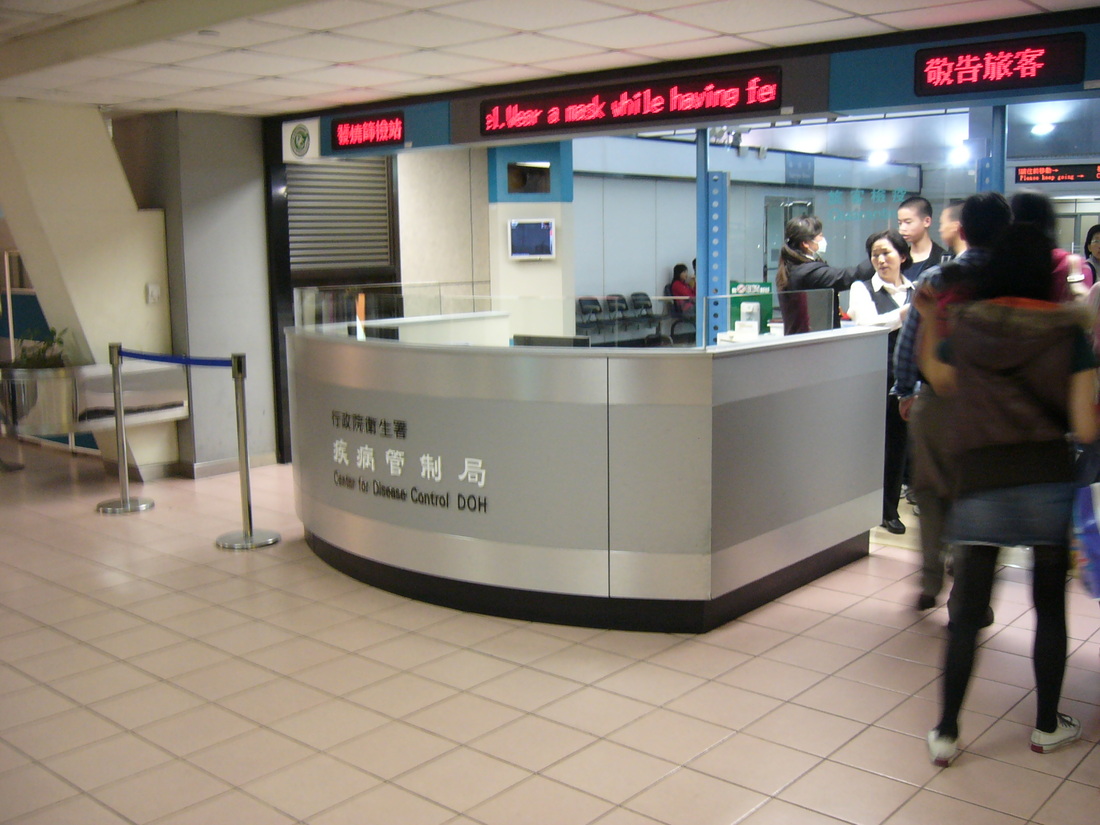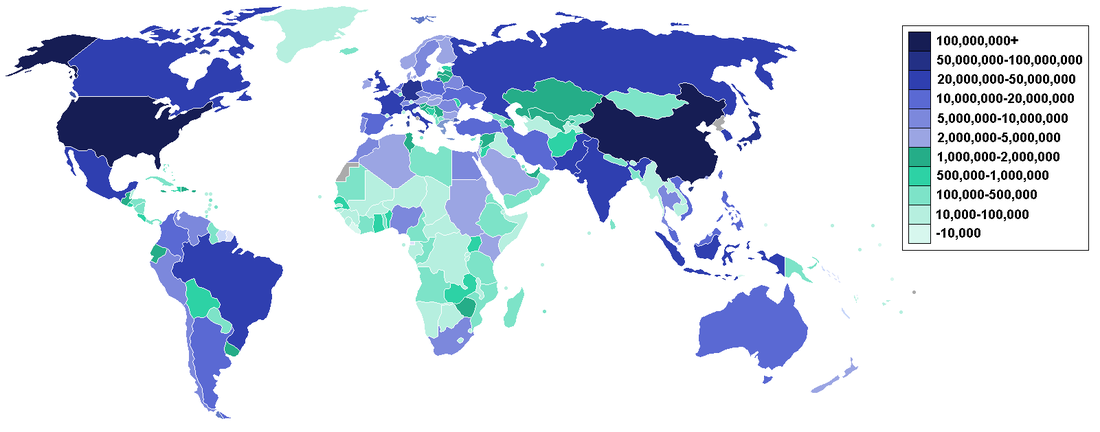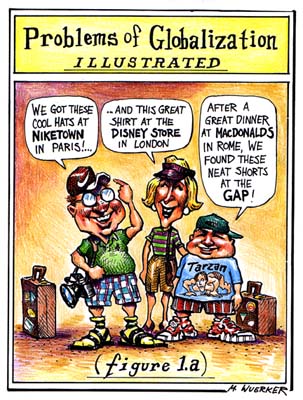Basic Gist
What is modern globalization
Globalization is the spread of ideas, viewpoints, goods and spread of cultures. In the 20th century, road vehicles and airlines made transportation even faster, and the advent of electronic communications. Science, technology and culture were spread even more quickly than ever before connecting people thousands of miles away. People would resist when an outside force would impose these things on a people, but when they were allowed to let these things naturally diffuse these factors would be more ready for people to use.
Science
With the world coming together through globalization, there has become much more awareness, concern, and action taken towards the problem of global health. The world now identifying itself more as one works to heal each other and shares technologies in doing so. Global health is the health of populations in a global context and transcends the perspectives and concerns of individual nations. Health problems that transcend national borders or have a global political and economic impact, are often emphasized. It has been defined as 'the area of study, research and practice that places a priority on improving health and achieving equity in health for all people worldwide'. Thus, global health is about worldwide improvement of health, reduction of disparities, and protection against global threats that disregard national borders.The major international agency for health is the World Health Organization (WHO). Other important agencies with impact on global health activities include UNICEF, World Food Programme, United Nations University International Institute for Global Health and the World Bank. Modern modes of transportation allow more people and products to travel around the world at a faster pace, but they also open the airways to disease spreading faster. This is very common in AIDS spreading to America.
Tecnology
The technology of globalization allows people to be connected to each always no matter where they are, as long as they have internet. Both a product of globalization as well as a catalyst, the Internet connects people around the world. In 2009, the number of Internet users was 1.858 billion. The size of total worldwide e-commerce, when global business-to-business and consumer transactions are added together, equates to $16 trillion in one year. The global market for digital products and services is valued at $4.4 trillion in 2013. The digital economy is equivalent to roughly 13.8% of global sales. The globalization caused by the internet has had a massive effect on not just the economy though. It has allowed the intermixing of cultures and created its own culture that the entire global identifies itself under.
Americanization Theory
When it comes to globalization of culture many analyst claim that there is a significant amount of "Americanization" occurring This is the idea the American culture is spreading and influencing nations across the globe. This is the reason we find McDonald's and Coca-cola across the world, and any where you go people will be wearing shoes with Nike swoosh. Many critiques feel this idea of Americanization is hurting the world because cultures and people are losing there true identity and values. As well as the idea that America is sticking their nose and economic influence into all corners of the world.
Criticisms of Globalization
Criticisms have arisen from church groups, national liberation factions, peasants and working class , intellectuals, and others. Some have been reformists in nature, (arguing for a more moderate form of capitalism) while others are more revolutionary (power shift from private to public control) or reactionary (public to private).
1. Poor countries at severe disadvantage in a globalized world
-rely on small scale agriculture, while globalized countries set market values and regulations for large scale farming.
2.Environmental opposition
Critiques and environmental protectionists claim Globalization excludes the majority, resources and wealth of society are appropriated by a small minority group of privileged race or class, which are so much under protection. Globalization is restructuring the control over resources in such a way that the natural resources of the poor are systematically taken over by the rich and the pollution of the rich is systematically dumped on the poor.
3. Anti-Consumerism
-Opposition to economic materialism comes primarily from two sources: religion and social activism. Some religions assert materialism interferes with connection between the individual and the divine, or that it is inherently an immortal lifestyle. Social activists believe materialism is connected to global retailing, greed, war, and environmental destruction.
4. Religious opposition
- Religious reasons are also cited, in which global governance is seen as the Biblical Antichrist or "New world Order" conspiracy theory. Such reasoning dates back to the founding of the League of Nations and United Nations.
- Advanced sciences and technologies are taking over the role of god and overtaking the importance of religious values in society
1. Poor countries at severe disadvantage in a globalized world
-rely on small scale agriculture, while globalized countries set market values and regulations for large scale farming.
2.Environmental opposition
Critiques and environmental protectionists claim Globalization excludes the majority, resources and wealth of society are appropriated by a small minority group of privileged race or class, which are so much under protection. Globalization is restructuring the control over resources in such a way that the natural resources of the poor are systematically taken over by the rich and the pollution of the rich is systematically dumped on the poor.
3. Anti-Consumerism
-Opposition to economic materialism comes primarily from two sources: religion and social activism. Some religions assert materialism interferes with connection between the individual and the divine, or that it is inherently an immortal lifestyle. Social activists believe materialism is connected to global retailing, greed, war, and environmental destruction.
4. Religious opposition
- Religious reasons are also cited, in which global governance is seen as the Biblical Antichrist or "New world Order" conspiracy theory. Such reasoning dates back to the founding of the League of Nations and United Nations.
- Advanced sciences and technologies are taking over the role of god and overtaking the importance of religious values in society
Works Cited
http://yaleglobal.yale.edu/content/modern-globalisation
http://www.economic-geography.org/index.php?option=com_content&view=article&id=95:modern-globalization&catid=98:inf&Itemid=85
http://earlymodernglobalization.humanities.ucla.edu
http://www.americanforeignrelations.com/E-N/Globalization-First-era-of-modern-globalization-to-1914.html#b
http://www.economic-geography.org/index.php?option=com_content&view=article&id=95:modern-globalization&catid=98:inf&Itemid=85
http://earlymodernglobalization.humanities.ucla.edu
http://www.americanforeignrelations.com/E-N/Globalization-First-era-of-modern-globalization-to-1914.html#b




